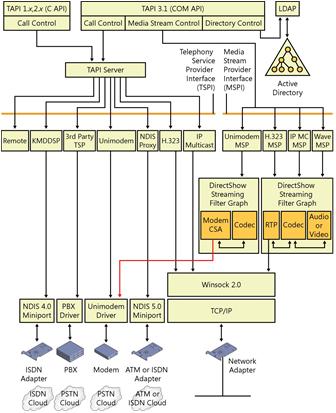Introduction
I noticed that there are many members who want to know how to create an Audio/Video Conferencing System using .NET. We know that there isn't any managed class that supports audio or video streaming in .NET, so I decided to write some applications that can help in writing your conferencing application. From time to time, you will find new examples and tutorials on VoIP, Video Conferencing and Network Programming on my site and also in our Forums that specialize in Network Programming and VoIP.
Introduction to H.323
H.323 is an umbrella recommendation from the ITU-T, that defines the protocols to provide audio-visual communication sessions on any packet network. It is currently implemented by various Internet real-time applications such as NetMeeting and Ekiga (the latter uses the OpenH323 implementation). It is a part of the H.32x series of protocols which also addresses communications over ISDN, PSTN or SS7. H.323 is commonly used in VoIP, Internet Telephony, or IP Telephony and IP-based videoconferencing. For more information about H.323, see Internet Telephony with H.323 on MSDN.
Introduction to TAPI 3 Telephony
TAPI version 3 is a COM-based API that merges classic and IP telephony. Possible applications range from simple voice calls over the Public Switched Telephone Network (PSTN) to multicast multimedia IP conferencing with quality of service (QOS).
There are four major components to TAPI 3:
Read more: Codeproject
I noticed that there are many members who want to know how to create an Audio/Video Conferencing System using .NET. We know that there isn't any managed class that supports audio or video streaming in .NET, so I decided to write some applications that can help in writing your conferencing application. From time to time, you will find new examples and tutorials on VoIP, Video Conferencing and Network Programming on my site and also in our Forums that specialize in Network Programming and VoIP.
Introduction to H.323
H.323 is an umbrella recommendation from the ITU-T, that defines the protocols to provide audio-visual communication sessions on any packet network. It is currently implemented by various Internet real-time applications such as NetMeeting and Ekiga (the latter uses the OpenH323 implementation). It is a part of the H.32x series of protocols which also addresses communications over ISDN, PSTN or SS7. H.323 is commonly used in VoIP, Internet Telephony, or IP Telephony and IP-based videoconferencing. For more information about H.323, see Internet Telephony with H.323 on MSDN.
Introduction to TAPI 3 Telephony
TAPI version 3 is a COM-based API that merges classic and IP telephony. Possible applications range from simple voice calls over the Public Switched Telephone Network (PSTN) to multicast multimedia IP conferencing with quality of service (QOS).
There are four major components to TAPI 3:
- COM API
- TAPI Server
- Telephony Service Providers (TSPs)
- Media Stream Providers (MSPs)
The API is implemented as a suite of Component Object Model (COM) objects. Moving TAPI to the object-oriented COM model allows developers to write TAPI-enabled applications in many languages, such as .NET, Java, or C++. Use of COM enables component upgrades of TAPI features.
The COM-based telephony API, TAPI 3.x, is available starting with Microsoft Windows X. TAPI 3.x provides greatly enhanced development tools for the modern world of communication programming, where a "call" may be a video stream on an IP-based network, and there is no phone set involved in the session.

The COM-based telephony API, TAPI 3.x, is available starting with Microsoft Windows X. TAPI 3.x provides greatly enhanced development tools for the modern world of communication programming, where a "call" may be a video stream on an IP-based network, and there is no phone set involved in the session.

Read more: Codeproject